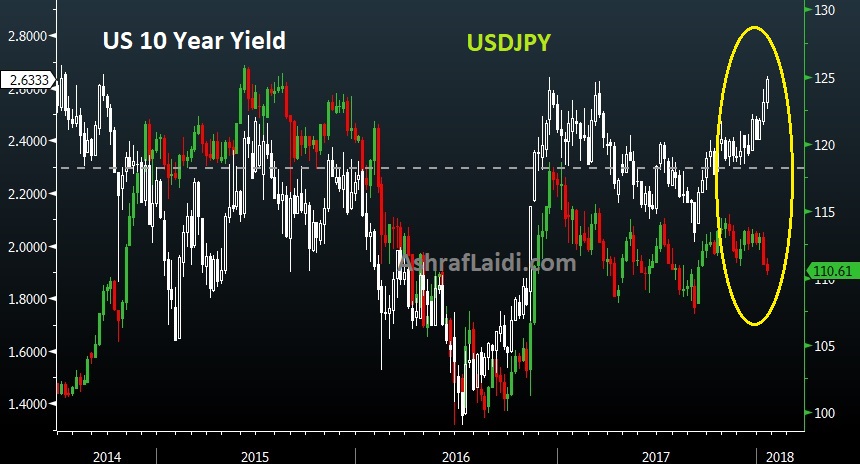
When a long-held market correlation begins to break, we wait to see if the divergence is temporary before making predictions whether the disparity will continue or not. Either way, we must attempt to have an accurate grasp about the causes to the correlation before explaining the break. One of these correlations is that of the yen and global yields. More specifically, USD/JPY and the US 10 year yield.
Why the Correlation?
Japan is the biggest net creditor to the world with a current account surplus at 3.8% of GDP, exceeding all major industrialized nations except for Switzerland.Why is that?
Since about 2003—when the Bank of Japan saw no other way but to deepen its path into zero interest rate policy (ZIRP) and ultimately quantitative easing—Japanese investors found little choice but to send their investments abroad to chase higher yields. These instruments ranged from US and European government bonds, to recovering equities and rallying commodities. US treasury securities were a popular choice for Japanese money due to their combination of higher yields, safety of investment and robust liquidity. As Japanese capital sought the yield carry, the great “carry trade” emerged with a declining yen alongside rising yields in the US and rest of the world. In good times, USD/JPY followed yields higher to reach 5-year highs in summer 2007 at 124 and 5.30% respectively.
The converse also applied. A cooling world economy brought down bond yields before the 2008-2009 deleveraging crisis sent them tumbling, forcing a violent unwinding of the carry trade. In December 2008, the US-10 year plunged to 2.04% and USD/JPY collapsed to 87.
Why the Divergence?
Since late October of last year, global yields began pushing higher due to synchronized advance in global growth, improved inflation expectations and tightening or normalizing of monetary policy. But the yen did not weaken. Why? :
- The Bank of Japan’s program of buying 10 trillion yen in Japanese govt bonds annually has managed to ease financial conditions to the extent of stabilizing inflation expectations and lifting yields on the 10-year bond above the 0% target.
- Although inflation remains at only 0.9%, it is on a rising trajectory, which means the Bank of Japan faces the highest upside (among other central banks) in monetary policy normalization . A clear positive for the yen.
- Japanese pension funds and insurers-- the biggest players in the yen carry trade—known for hedging their purchases of foreign bonds, have tilted their hedge ratios higher against the risk of their interest earnings losing value when converted back to yen. Less yen hedging is another positive for the yen.
Will it Last?
Focusing on USD/JPY versus 10-year yields, it could be argued that market expectations of 3 rate hikes from the Fed this year will overwhelm any normalization efforts from the BoJ at the expense of the yen –to the benefit of USD/JPY. But as we have seen over the last 2 years, the Fed’s annual rate hikes have barely matched projections.
If you believe that the global bond market rally has finally ended and bond yields are heading higher, then will that be too much for Japanese investors to resist and keep money at home? The answer is a strong “No”.
But there are two other important items:
- I remain on the fence with regards to the view of continued rising bond yields (see explanation in the last 2 videos here and here)
- Japanese flows overseas will remain hedged, especially as the Fed is nearer to the end of its policy tightening while the BoJ is far from starting.
Regardless of whether the correlation between USD/JPY and bond yields is reinstated or diverges further, the case for a robust yen remains clear.
